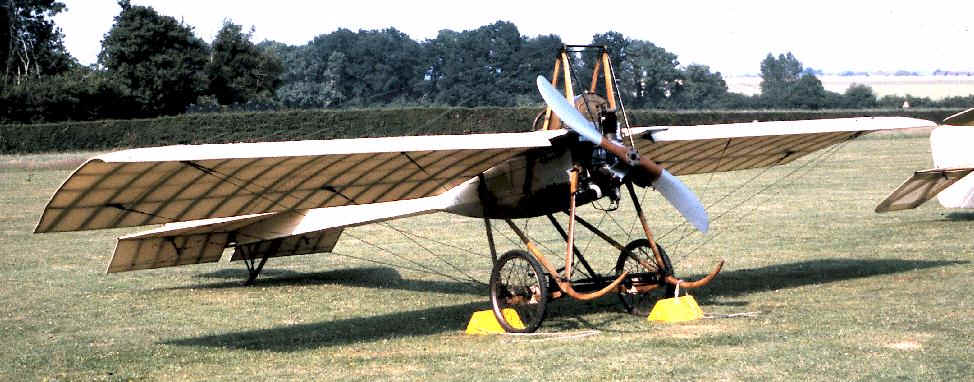
Image du Jours -- Early Aviation
Return to Story IndexNext Early Aviation Image du Jour
About Early Aviation -- #4 of 7.

Deperdussin
(K. Cashion) AIR RACINGThe 1911 French Deperdussin looks like a more complete aircraft than the Bleriot and though the construction was the same as for the Bleriot, it does have the aft fuselage covered, has a fin, and stabilizer with elevator.
It, too, used wing warping but the principal Anzani engine was a little more advanced and the three cylinders were mounted evenly around the crankshaft. This necessitated that the engine not be mounted to a horizontal shelf as was done on the Bleriot, but mounted by its crankcase back to a firewall. The CG placement required that the engine be mounted behind the wing’s leading edge.
The landing gear was now the traditional bungee wrapping of the axle to a rigid undercarriage, and this structure made up the central part of the airframe. This arrangement will continue well into the 1930s.
The artistically steam-bent horns in front of the landing gear was an attempt to keep the Deperdussin off its short nose and right-side-up. It would also offer some protection for the expensive prop. A prop strike could severely damage the engine and airframe.
The gravity-fed fuel tank was mounted high, near the engine to balance the aircraft and it was the only protection the pilot had from the air-stream. The fuel tank was mounted over the pilot's legs, all in an attempt to get the most weight (pilot, fuel, and engine) close to the CG. (The pilot of the Bleriot was also pretty-much sitting up in the wind.)
Subsequent Deperdussin models used engines developing as much as 100 hp and carrying three people.
These Deperdussins did well in early Schneider Cup racing, but this one is the more common model. In 1910, these were sold ready-to-fly for about $1,200. (This would be $28,000 in 2011 dollars.)
Bleriot and his own aircraft had become very popular and he produced over 800 Bleriot aircraft before 1914. But also in 1914, Bleriot took over the Deperdussin factory, and by 1918 was producing 18 aircraft a day there.
The Deperdussin shown here served at the Hendon flying school alongside the previously seen, Bleriot XI. Just before WWI, it, too, was purchased by Mr. Grimmer and both were flown at a polo field. Richard Shuttleworth purchased this aircraft, rebuilt it, and then both it and his Bleriot were flown at fairs and expositions until the beginning of WWII.
Though a little more stable than the Bleriot, it is still limited to general, straight hops across the field but on perfect afternoons, it has made full circuits of the Old Warden Aerodrome.
In 1913, a Deperdussin won the first Schneider Cup race by out-lasting the competition. Its recorded time would have been even better had it not landed prematurely because of a time-keeper's error. The pilot just took off again, flew the rest of the lap, returned, and landed to re-start the festivities and complete the celebrations.
Most aviation enthusiasts know that the Schneider Cup was for the speediest seaplanes. And they know that when the British Ministry of Aviation advised against Britain participating in subsequent races because of the expense, a Lady Houston made the gracious donation of £500,000 from her personal fortune. This was to keep Britain in the competition. The final product of this donation was the Supermarine Spitfire; however, while many enthusiasts may recognize the various entrants, they may know little about the qualifications for the Schneider Cup races.
All the seaplanes had to undergo a series of trials to prohibit a pure, out-and-out race plane from entering the competition. Not many people know that before the entry could be accepted for the speed runs, it had to:
- taxi over the water in rough seas beyond the starting line under its own power;
- start and, after executing a loop, land;
- move on the water under its own power at a minimum speed of 12 mph over a 1/2-mile stretch of open sea between buoys;
- repeat the above procedure;
- start and land once again;
- and then stay anchored for 6 hours to demonstrate its buoyancy and to prove that it remained seaworthy even while moored.
So it only took one decade to go from the novelty of merely surviving flight to competing in speed events and demonstrating aviation practicality.
These aviation pioneers -- those who sat up in the wind and who were pleased to gain wicker seats, had to learn the hard way that a seat belt was needed for general flying. And there were important things to think about during the last minutes of flight -- these aeronautists deserve our occasional, serious consideration, appreciation, and admiration because we too-often think of them in a comical light. This is because we think of them in our Context...Presentism.
These brave people had a brotherhood that crossed international boundaries.
A burned and dying early aeronautist lay in a field beside the smoking remains of his elementary aeroplane and his last words were, "Tell them to turn off the magneto..."
Ken Cashion
Next Early Aviation Image du Jour
Return to Story Index